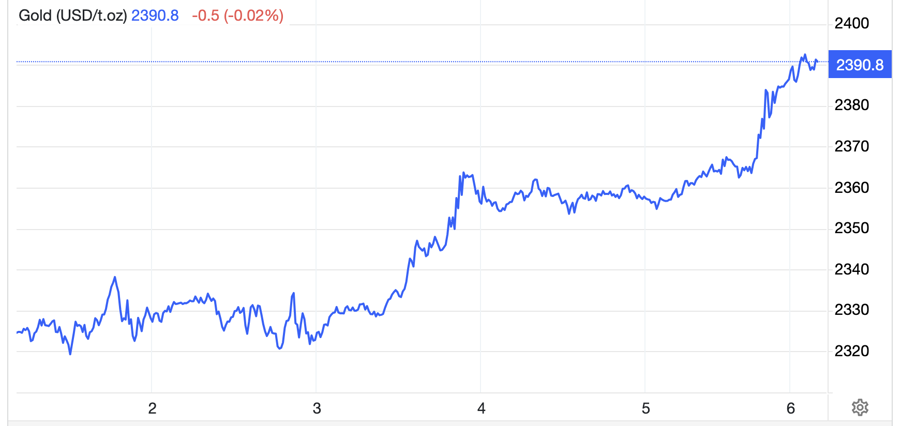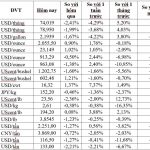Gold prices surged during Friday’s trading session (July 5th), reaching their highest level since early June, as U.S. jobs data bolstered expectations for a Federal Reserve rate cut in September. Analysts predict that next week will be a crucial test for gold prices, as the key $2,400 per ounce level is within reach.
At the close of trading in New York, spot gold prices rose by $32.60 per ounce, or 1.38%, to $2,389.60 per ounce, according to data from Kitco. When converted using Vietcombank’s selling rate for USD, this price equates to VND 73.3 million per tael, an increase of VND 0.9 million per tael compared to the previous day.
“Gold prices are at a one-month high due to downward revisions in May’s employment data and an uptick in June’s unemployment rate. All of this data reinforces the likelihood of a Fed rate cut in September,” said Tai Wong, a precious metals trader in New York. “Gold bulls are eyeing the record high of $2,450 per ounce, and this price level could come into play again if the Fed starts signaling a clear choice of September for easing.”
According to the U.S. Department of Labor, the non-farm sector of the economy added 206,000 new jobs in June, more than the 200,000 new jobs predicted by economists in a Dow Jones poll, but fewer than the downwardly revised 218,000 new jobs created in May. The unemployment rate rose to 4.1%, instead of remaining steady at the expected 4%.
Average hourly earnings increased by 0.3% in June from the previous month and were up 3.9% from a year earlier, both in line with forecasts.
Based on data from the FedWatch Tool on the CME trading platform, the market is betting on a 77% likelihood of a 0.25-percentage-point rate cut by the Fed in September, up from 64% a week ago.
Additionally, traders are increasing their bets on the possibility of two rate cuts by the Fed this year, with the second cut occurring in December.
As gold is a non-interest-bearing asset, the prospect of lower interest rates benefits gold prices. Moreover, gold prices are also propelled by declining yields on U.S. Treasury bonds and a weaker U.S. dollar.
The yield on the 10-year U.S. Treasury bond closed Friday’s session down 6.9 basis points at 4.277%. The Dollar Index, which measures the strength of the U.S. dollar against a basket of six other major currencies, fell by 0.24% to close at 104.88 points, its lowest level in three weeks.
For the week, the Dollar Index declined by 0.94%, according to data from MarketWatch.
The world’s largest gold-backed exchange-traded fund, SPDR Gold Trust, purchased a net amount of 5.7 tons of gold this week, equivalent to a nearly 0.7% increase in holdings, bringing the total amount held to 834.8 tons.

Speaking to Kitco News, technical analyst Ricardo Evangelista from ActivTrades stated that it wouldn’t be surprising if gold prices reclaimed the $2,400 per ounce level next week.
“As expected, today’s jobs data confirmed that the U.S. job market continues to weaken, even if not by a large amount, but still enough to support the case for a Fed rate cut. In the first half of this year, the resilience of the U.S. economy had suggested the possibility of the Fed keeping rates higher for longer, so signs of an economic slowdown could pull down the dollar and U.S. Treasury bond yields, creating a supportive environment for gold,” said Evangelista.
Olen Hansen, Head of Commodity Strategy at Saxo Bank, opined that it might be a bit early to conclude that the accumulation period for gold prices is over, but he remains confident that the primary trend for gold is upward.
“I am a bit surprised that gold prices have risen so high, but it’s true that the recent correction was very shallow, indicating strong demand for gold at lower price levels. Or it could simply be that bulls don’t see any reason to reduce their gold holdings,” said Hansen.
With the U.S. economy decelerating, the most significant remaining risk factor for gold prices is inflation. Next week, two crucial inflation reports from the U.S. will be released: the Consumer Price Index (CPI) on Thursday and the Producer Price Index (PPI) on Friday. However, analysts believe that inflationary risks will be limited, as slower economic growth will lead to reduced upward pressure on prices.
Market Update on February 2nd: Oil, Copper, Iron & Steel, Rubber, and Sugar Prices Decline, Gold Surges to Almost 1-Month High.
At the end of the trading session on February 1st, the prices of oil, copper, iron and steel, rubber, and sugar all dropped, while natural gas hit a nine-month low and gold reached its highest point in nearly a month.













